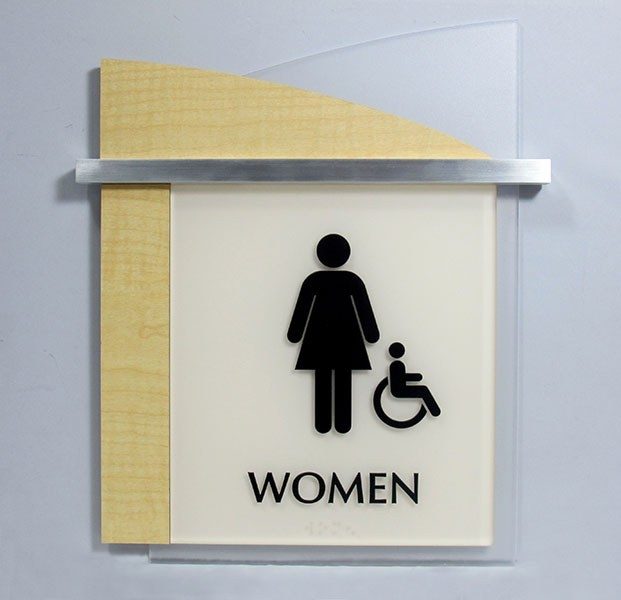Just How ADA Signs Improve Availability for Everyone
Just How ADA Signs Improve Availability for Everyone
Blog Article
Exploring the Key Functions of ADA Signs for Boosted Availability
In the realm of access, ADA signs serve as silent yet effective allies, guaranteeing that rooms are navigable and inclusive for individuals with disabilities. By integrating Braille and responsive aspects, these indications break obstacles for the visually damaged, while high-contrast shade schemes and legible typefaces provide to varied visual needs.
Value of ADA Conformity
Guaranteeing compliance with the Americans with Disabilities Act (ADA) is essential for cultivating inclusivity and equivalent gain access to in public rooms and offices. The ADA, enacted in 1990, mandates that all public centers, companies, and transport solutions fit people with disabilities, ensuring they take pleasure in the very same civil liberties and possibilities as others. Conformity with ADA standards not only meets legal responsibilities but also boosts an organization's reputation by demonstrating its dedication to diversity and inclusivity.
One of the essential elements of ADA compliance is the implementation of accessible signage. ADA indications are created to guarantee that people with specials needs can conveniently browse with structures and spaces.
Additionally, sticking to ADA laws can alleviate the risk of lawful effects and potential penalties. Organizations that fall short to adhere to ADA standards may face legal actions or penalties, which can be both economically difficult and destructive to their public image. Thus, ADA compliance is important to cultivating a fair setting for everyone.
Braille and Tactile Components
The consolidation of Braille and responsive aspects right into ADA signage embodies the concepts of ease of access and inclusivity. It is generally positioned beneath the matching text on signage to ensure that individuals can access the information without aesthetic support.
Responsive components extend past Braille and include increased symbols and characters. These elements are made to be discernible by touch, enabling people to identify space numbers, bathrooms, leaves, and other vital areas. The ADA establishes details guidelines concerning the dimension, spacing, and placement of these responsive elements to maximize readability and ensure consistency throughout various environments.

High-Contrast Color Pattern
High-contrast color systems play a critical role in improving the presence and readability of ADA signs for individuals with aesthetic impairments. These schemes are essential as they optimize the difference in light reflectance between text and history, guaranteeing that signs are easily noticeable, also from a range. The Americans with Disabilities Act (ADA) mandates making use of particular shade contrasts to accommodate those with minimal vision, making it an essential facet of conformity.
The effectiveness of high-contrast shades exists in their capacity to attract attention in various lighting problems, consisting of poorly lit settings and locations with glow. Commonly, dark message on a light background or light text on a dark background is utilized to accomplish ideal comparison. As an example, black text on a white or yellow history provides a plain visual distinction that helps in fast recognition and understanding.

Legible Fonts and Text Dimension
When considering the design of ADA signs, the choice of understandable font styles and ideal text dimension can not be overstated. The Americans with Disabilities Act (ADA) mandates that font styles should be not italic and sans-serif, oblique, manuscript, highly ornamental, or of unusual form.
According to ADA guidelines, the minimum message elevation should be 5/8 inch, and it needs to raise proportionally with checking out range. Consistency in text size adds to a cohesive aesthetic experience, helping people in navigating atmospheres effectively.
Furthermore, spacing between lines and letters is indispensable to readability. Adequate spacing avoids characters from appearing crowded, boosting readability. By adhering to these requirements, developers can dramatically improve ease of access, ensuring that signs offers its designated purpose for all people, no matter their visual capabilities.
Efficient Placement Techniques
Strategic placement of ADA signage is necessary for making best use of availability and ensuring compliance with legal requirements. Appropriately positioned indications assist individuals with handicaps effectively, promoting navigating in public spaces. Key considerations include elevation, proximity, and visibility. ADA guidelines stipulate that indications should be placed at an elevation between 48 to 60 inches from the ground to ensure they are within the line of sight for both standing and seated individuals. This common elevation array is crucial for inclusivity, making it possible for mobility device customers and individuals of varying elevations to access information easily.
In addition, indicators have to be placed beside the lock side of doors to permit simple identification before access. This positioning aids people locate spaces and spaces without blockage. In situations where there is no door, signs ought to be located on the local surrounding wall. Uniformity in indicator placement throughout a facility boosts predictability, lowering complication and improving overall individual experience.

Verdict
ADA signs play an important role in promoting ease of access by integrating functions that attend to the needs of individuals with handicaps. These aspects collectively foster an inclusive atmosphere, highlighting the significance of ADA compliance in guaranteeing equal accessibility for all.
In the world of access, ADA indicators serve as silent yet effective allies, ensuring that news spaces are accessible and inclusive for people with handicaps. The ADA, established in 1990, mandates that all public centers, employers, and transport services suit people with disabilities, guaranteeing they delight in the exact same rights and chances as others. ADA Signs. ADA indications are made to guarantee that individuals with handicaps can conveniently navigate via spaces and structures. ADA guidelines state that indicators must be placed at an elevation in between 48 to 60 inches from the ground to ensure they are within the line of sight for both standing and seated people.ADA signs play a crucial duty in promoting access by incorporating features that attend to the needs of individuals with impairments
Report this page